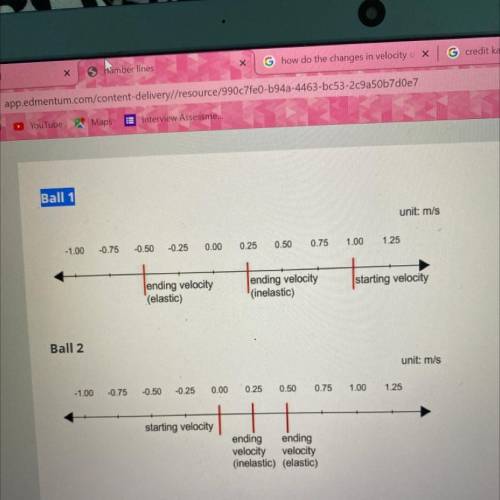Question 3: Comparing Elastic and Inelastic Collisions
Part A
How do the changes in velocity...

Physics, 09.01.2021 19:20 yclark98563p5z2gt
Question 3: Comparing Elastic and Inelastic Collisions
Part A
How do the changes in velocity of ball 1 and ball 2 compare in elastic (bouncy) and inelastic (sticky) collisions? Use these
number lines to help you decide.


Answers: 2
Another question on Physics

Physics, 22.06.2019 06:50
What is the stall speed at sea level of an airplane that weights 10000 lbs., has a wing area of 300ft^2, and a maximum lift coefficient of 1.4? what is the stall speed if flaps that double cl,max are applied?
Answers: 1

Physics, 22.06.2019 09:30
Suppose you increase your walking speed from 7 m/s to 13 m/s in a period of 2 s. what is your acceleration?
Answers: 2

Physics, 22.06.2019 19:30
Select light for the type of wave, adjust the wavelength so that the light is red, and increase the amplitude of the light to the max. then, select the start button at the source location to begin producing the waves. light is a form of electromagnetic wave, containing oscillating electric and magnetic fields. the wave amplitude detector mentioned above shows how the electric field oscillates in time at the location of the probe. the amplitude of the wave at the location of the probe is equal to the maximum electric field measured. how does the amplitude of the wave depend on the distance from the source?
Answers: 2

Physics, 23.06.2019 22:50
You are now given an additional piece of information: it takes five complete revolutions for the turntable to speed up from 3313rpm to 45rpm. which of the following equations could you use to directly solve for the numerical value of the angular acceleration α?
Answers: 1
You know the right answer?
Questions

Mathematics, 06.05.2020 01:05


Mathematics, 06.05.2020 01:05


Mathematics, 06.05.2020 01:05

History, 06.05.2020 01:06

Mathematics, 06.05.2020 01:06




Mathematics, 06.05.2020 01:06




English, 06.05.2020 01:06





Health, 06.05.2020 01:06



